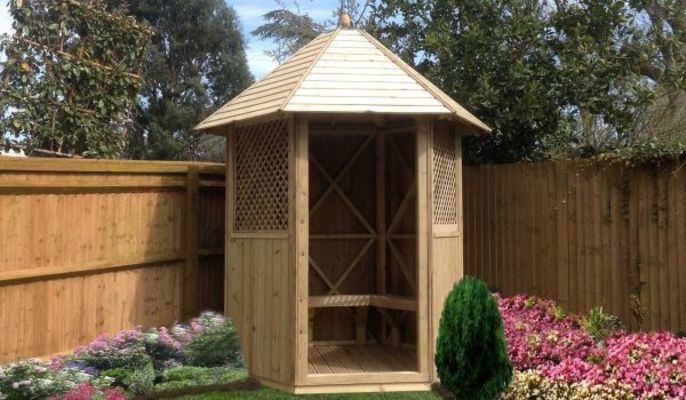Octagonal Gazebo Blueprints
Plans To Make 12 Feet Square Pergola : Items To Remember While Putting Together A Backyard Pavilion

When positioning your next board, you should leave a small gap for expansion during wet weather, though not so large so as to create a large gap should your planks shrink. Since the number of garrets is odd, one of them should be in the exact center of the purlin. Traditional timber framing requires very complex joinery, and both timber framing and post and beam use heavy members that one can't hoist alone. If you want a little help, find someone to help build your (https://www.squaregazeboplans.com/large-gazebo-plans) pergola. You can then use the square to transfer the angle for the cut to the lumber.
Heat lamps and electric heaters are often the warmest and safest options, especially if the area is covered or partially enclosed. However, a seasoned handyman may prefer to build his own from scratch. Because a pavilion can often be built in only a weekend, it is important to have all the materials available before beginning to build. By measuring between these lines, we can calculate the length of the ledger. The interior drop down height should be no lower than 80 inches which is a standard doorway height so that is a good place to start. It provides a peaceful atmosphere for you and your family to enjoy.
It has shingles on the roof and a solid and sturdy construction but at the same time it looks slender and graceful. A pergola with a solid roof, this one is covered (go right here) in thatch, will provide the complete shade that is necessary in hot climates. That way if you make a mistake, you can move over a bit and try again. It is sometimes wise to drill the nail holes first with a slightly smaller drill bit to minimize the chance of the timber splitting. Fasten each beam in place after clamping it to the posts. Building an octagonal gazebo is a complex project, as it requires a large investment and quality materials.
Procesando video...
Smooth the edges with sandpaper for a professional result. Build up the perimeter with soil to keep the base material from spreading outward as you compact. Then, take the top board and place it above your balusters. Do the same with the next post base in line, then repeat these steps for the other side of the pergola. Sewing would be the best option if possible. Space was limited but the open design of a gazebo lends itself well to this. Perhaps something similar will make and with doors. However, the wire strands would fail if subjected to constant flexing, so the material should be firmly affixed with nails or staples to a structure that is rigid.
Trim with a circular saw if needed. Repeat the process for the back rest. First of all I'm cutting the rafters. Tighten it up as much as you can. Cables and exposed bolts add an up-to-date flair and places to hang plants. Simply adjust the square to the desired pitch and lock in place with the knurled knob. If you're looking to add interest to your outdoor space, define a walkway, or separate different parts of your garden, consider building a pavilion or arbour. Local codes may limit the step rise to 7 inches instead. This project was made from rock, stone colored bricks, and redwood.
This softwood is of high quality and easy to work with. Should be fun, so tune in and let's have some fun. Here is where you would need extra hands and your post level and regular levels. So the idea here, if it's not clear, is to build the roof completely on the ground, and then lift it up in position and secure it to the posts. If the overhead is attached to the house, the ledger takes the place of a beam, supporting the eaves directly. Always round the step count up, yielding three steps in this example. They are the most commonly used materials for posts, beams, rafters, and open-style roofing.
This is where we needed to cut with a hand saw. Use a little motor oil on the bit as you drill to keep the bit cool. The braces were the last to go on. The last tamping would vibrate the sand into the joints, locking all the bricks together. You'll find tips for slashing heating bills, growing fresh, natural produce at home, and more. You can make it as shady as you like by adding climbing plants and creepers, or by topping off the structure with a sheet of fabric.